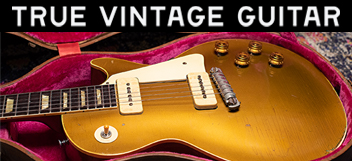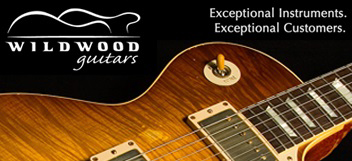BigsbyTracks
Active member
- Joined
- Aug 4, 2001
- Messages
- 5,793
This week I picked up this early 70's Bandmaster Reverb chassis. It came in a 2x10 combo cabinet equipped with Oxford 10L6 speakers. The chassis has seen better days and the covering work on the repro cabinet is flawed, but the amp has been well maintained. As I found when I played it (and later looked at the circuit) it appears to have been carefully tuned to be a great blues/rock lead amp.

Inside, the amp is actually fairly straight (stock transformers and overall circuit). It has the signs of respectful blackfacing (bias level control, 82K/100K phase inverter resistors) and maintenance with contemporary parts (e.g. 715P orange drops and silver mica caps here and there). The tube complement is nicely selected and mostly US old stock and new Central European tubes.
Being a Bandmaster Reverb chassis, the output transformer is the smaller unit found in Pro Reverbs and Vibrolux Reverbs, instead of the beefy Super Reverb model. These saturate and overdrive fairly quickly, and that's why the Vibroclone guys replace them with Twin Reverb iron. But if overdrive and saturation is what you want, then the stock transformer may be an advantage.
Another characteristic that the Super, Pro, and Vibrolux amps share is the tube rectifier, which again contributes to compression and sag at high levels.
Beyond the smaller output transformer and tube rectifier, though, there are a few other things about this particular amp that I think really add to the overall picture.
First, the initial dropping resistors in the power supply are larger than the stock values. The result is that even in my city where the AC is sometimes 128V instead of the 110V that Fender power transformers were designed for, the voltages are in fact dead on to the original voltages on the Fender schematics I have. This avoids exaggerated harshness from higher voltages, and the higher resistor values may contribute to the amount of sag in the power supply as well.
Second, the negative feedback resistor was changed from 820 ohms to 1.5K, so the feedback from the speakers is is reduced from 100:820 to 100:1500 - roughly halved. Output stage distortion comes on a little faster and more gradually when it does - again, great for blues and rock.
Thirdly, the tone stack on a Bandmaster Reverb/Super Reverb chassis has a midrange control, and also uses .022/.022 values for the tone stack instead of the .1/.047 found on other amps like my Vibrolux Reverb. The preamp can simply pass on more midrange to the power amp than the smaller amps without mid controls.
Fourth - the 60's Oxfords in the cabinet are great sounding speakers with a nice balance from low to high, but they are not as efficient as the Weber 12F150's in my Vibrolux. So the amp has to work harder to get the same volume level = more overdrive.
The overall picture is that this amp really gives it up at high volume settings. It has nice touch response and "sag", and the extra mids and reduced negative feedback contribute to a smooth, sustained tone with what I guess is called "swirl", when the note changes as it sustains.
I definitely got what I wanted this week when I picked up yet another Fender amp - the chance to learn something! The real eye openers for me were about the decreased negative feedback and the Oxfords. So much so that I reinstalled the Oxfords that came in my Vibrolux Reverb to give them a second listen.
I don't know why I'm typing all this (beyond the usual pleasure of talking about a gear purchase) except maybe to share the learning experience about the amp and how everything fits together. :wah
As for how it sounds - this afternoon I did a brief YouTube video of the amp. This one actually features the clean tone (and how it sounds with pedals) more rather than the full-out tone. I'll have to do that when the neighbors are out - the amp is still quite loud!
Fishmaster

Inside, the amp is actually fairly straight (stock transformers and overall circuit). It has the signs of respectful blackfacing (bias level control, 82K/100K phase inverter resistors) and maintenance with contemporary parts (e.g. 715P orange drops and silver mica caps here and there). The tube complement is nicely selected and mostly US old stock and new Central European tubes.
Being a Bandmaster Reverb chassis, the output transformer is the smaller unit found in Pro Reverbs and Vibrolux Reverbs, instead of the beefy Super Reverb model. These saturate and overdrive fairly quickly, and that's why the Vibroclone guys replace them with Twin Reverb iron. But if overdrive and saturation is what you want, then the stock transformer may be an advantage.
Another characteristic that the Super, Pro, and Vibrolux amps share is the tube rectifier, which again contributes to compression and sag at high levels.
Beyond the smaller output transformer and tube rectifier, though, there are a few other things about this particular amp that I think really add to the overall picture.
First, the initial dropping resistors in the power supply are larger than the stock values. The result is that even in my city where the AC is sometimes 128V instead of the 110V that Fender power transformers were designed for, the voltages are in fact dead on to the original voltages on the Fender schematics I have. This avoids exaggerated harshness from higher voltages, and the higher resistor values may contribute to the amount of sag in the power supply as well.
Second, the negative feedback resistor was changed from 820 ohms to 1.5K, so the feedback from the speakers is is reduced from 100:820 to 100:1500 - roughly halved. Output stage distortion comes on a little faster and more gradually when it does - again, great for blues and rock.
Thirdly, the tone stack on a Bandmaster Reverb/Super Reverb chassis has a midrange control, and also uses .022/.022 values for the tone stack instead of the .1/.047 found on other amps like my Vibrolux Reverb. The preamp can simply pass on more midrange to the power amp than the smaller amps without mid controls.
Fourth - the 60's Oxfords in the cabinet are great sounding speakers with a nice balance from low to high, but they are not as efficient as the Weber 12F150's in my Vibrolux. So the amp has to work harder to get the same volume level = more overdrive.
The overall picture is that this amp really gives it up at high volume settings. It has nice touch response and "sag", and the extra mids and reduced negative feedback contribute to a smooth, sustained tone with what I guess is called "swirl", when the note changes as it sustains.
I definitely got what I wanted this week when I picked up yet another Fender amp - the chance to learn something! The real eye openers for me were about the decreased negative feedback and the Oxfords. So much so that I reinstalled the Oxfords that came in my Vibrolux Reverb to give them a second listen.
I don't know why I'm typing all this (beyond the usual pleasure of talking about a gear purchase) except maybe to share the learning experience about the amp and how everything fits together. :wah
As for how it sounds - this afternoon I did a brief YouTube video of the amp. This one actually features the clean tone (and how it sounds with pedals) more rather than the full-out tone. I'll have to do that when the neighbors are out - the amp is still quite loud!
Fishmaster
Last edited:



